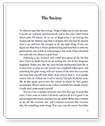Grieving Essays and Research Papers
Instructions for Grieving College Essay Examples
Title: Perform a literature search grieving process readings module GCU Library websites materials disposal Focus work Kbler Ross grieving process stages grief Review story Job Bible focusing suffering grief
Total Pages: 4 Words: 1302 References: 6 Citation Style: APA Document Type: Essay
Title: The effects on clinicians offering supportive intervention in complex grieving situations
Total Pages: 8 Words: 3316 Works Cited: 0 Citation Style: MLA Document Type: Research Paper
Title: Kubler Ross and the story of Job
Total Pages: 3 Words: 1104 Bibliography: 3 Citation Style: APA Document Type: Essay
Title: COPING WITH DISEASE AND DEATH
Total Pages: 6 Words: 2234 Sources: 10 Citation Style: APA Document Type: Research Paper


